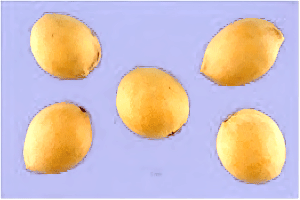FabulousFusionFood's Spice Guide for Mahlab Home Page
 Five pits of the
mahlab cherry,
Prunus
mahaleb.
Five pits of the
mahlab cherry,
Prunus
mahaleb.
Welcome to the summary page for FabulousFusionFood's Spice guide to Mahlab along with all the Mahlab containing recipes presented on this site, with 5 recipes in total.
This is a continuation of an entire series of pages that will, I hope, allow my visitors to better navigate this site. As well as displaying recipes by name, country and region of origin I am now planning a whole series of pages where recipes can be located by meal type and main ingredient. This page gives a listing of all the Cornish recipes added to this site.
These recipes, all contain as a major flavouring.
Mahlab (also Mahleb, or Mahlepi and in English: English cherry, Rock cherry, St. Lucie cherry) is an aromatic spice derived from the pulverized pits of the black cherry Prunus mahaleb. It has been used for centuries in the Middle East and the surrounding areas (especially in Turkey, Lebanon, Syria, Palestine, Armenia, Iran and Greece) as a sweet/sour, nutty addition to breads, cheese, and biscuits (cookies).
Mahleb is used in Greece, where it is known as 'Mahlepi' for holiday cakes such as tsoureki and similar egg-rich yeast cakes and biscuits. In the Middle East and Anatolia it is also associated with Ramadan sweets, including 'Tsourek', 'Ka'kat' and 'Maamoul'. It is also the flavoring of the traditional Armenian holiday cake, 'Choereg'. In Cyprus, it is used in a special Easter cheese pie or cheese cake called 'flaounes' (φλαούνες). Recent interest in Mediterranean cooking has increased the profile and availability of this spice.
The mahlab embryo is soft-textured and tastes bitter and aromatic. After some time of chewing, a subtle flavour of tonka beans or bitter almond develops. Unlike bitter almonds, no cyanogenic glycosides have been found in mahlab cherry kernels and the main flavour compounds seem to be coumarin derivatives. Mahaleb cherry grows abundantly in the Mediterranean, Southeast Europe and West Asia; it is, however, sometimes found in Central Europe, where it prefers warm and dry climate. Its culinary use is restricted to the South Eastern part of Europe (Greece, Armenia) and West Asia (Turkey, Lebanon, Syria). Main export country is Syria.
The name of the spice is derived from either the Arabic [محلب] (which is variously transcribed as: mahlab, mahalab, mahleb or mahaleb), the Turkish (mahlep or mahalep) or the Greek [μαχλέπι] (which is transcribed as mahlepi, machlepi or makhlepi).
This is a continuation of an entire series of pages that will, I hope, allow my visitors to better navigate this site. As well as displaying recipes by name, country and region of origin I am now planning a whole series of pages where recipes can be located by meal type and main ingredient. This page gives a listing of all the Cornish recipes added to this site.
These recipes, all contain as a major flavouring.
Mahlab (also Mahleb, or Mahlepi and in English: English cherry, Rock cherry, St. Lucie cherry) is an aromatic spice derived from the pulverized pits of the black cherry Prunus mahaleb. It has been used for centuries in the Middle East and the surrounding areas (especially in Turkey, Lebanon, Syria, Palestine, Armenia, Iran and Greece) as a sweet/sour, nutty addition to breads, cheese, and biscuits (cookies).
Mahleb is used in Greece, where it is known as 'Mahlepi' for holiday cakes such as tsoureki and similar egg-rich yeast cakes and biscuits. In the Middle East and Anatolia it is also associated with Ramadan sweets, including 'Tsourek', 'Ka'kat' and 'Maamoul'. It is also the flavoring of the traditional Armenian holiday cake, 'Choereg'. In Cyprus, it is used in a special Easter cheese pie or cheese cake called 'flaounes' (φλαούνες). Recent interest in Mediterranean cooking has increased the profile and availability of this spice.
The mahlab embryo is soft-textured and tastes bitter and aromatic. After some time of chewing, a subtle flavour of tonka beans or bitter almond develops. Unlike bitter almonds, no cyanogenic glycosides have been found in mahlab cherry kernels and the main flavour compounds seem to be coumarin derivatives. Mahaleb cherry grows abundantly in the Mediterranean, Southeast Europe and West Asia; it is, however, sometimes found in Central Europe, where it prefers warm and dry climate. Its culinary use is restricted to the South Eastern part of Europe (Greece, Armenia) and West Asia (Turkey, Lebanon, Syria). Main export country is Syria.
The name of the spice is derived from either the Arabic [محلب] (which is variously transcribed as: mahlab, mahalab, mahleb or mahaleb), the Turkish (mahlep or mahalep) or the Greek [μαχλέπι] (which is transcribed as mahlepi, machlepi or makhlepi).
The alphabetical list of all Mahlab recipes on this site follows, (limited to 100 recipes per page). There are 5 recipes in total:
Page 1 of 1
| Assabeh Tamr (Date Fingers) Origin: Arabic | Chuoereg (Armenian Easter Bread) Origin: Armenia | Lambropsomo (Greek Easter Bread) Origin: Greece |
| Cheoreg (Armenian Sweet Bread) Origin: Armenia | Ka'ak Biscuits Origin: Lebanon |
Page 1 of 1